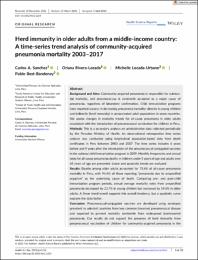| dc.contributor.author | Sanchez, Carlos A. | |
| dc.contributor.author | Rivera-Lozada, Oriana | |
| dc.contributor.author | Lozada-Urbano, Michelle | |
| dc.contributor.author | Best-Bandenay, Pablo | |
| dc.date.accessioned | 2023-09-18T14:46:03Z | |
| dc.date.available | 2023-09-18T14:46:03Z | |
| dc.date.issued | 2023-05-03 | |
| dc.identifier.uri | https://hdl.handle.net/20.500.13053/9362 | |
| dc.description.abstract | “Background and Aims
Community-acquired pneumonia is responsible for substantial mortality, and pneumococcus is commonly accepted as a major cause of pneumonia, regardless of laboratory confirmation. Child immunization programs have reported success in decreasing pneumonia mortality: directly in young children and indirectly (herd immunity) in unvaccinated adult populations in some countries. We assess changes in mortality trends for all-cause pneumonia in older adults associated with the introduction of pneumococcal vaccination for children in Peru.
Methods
This is a secondary analysis on administrative data collected periodically by the Peruvian Ministry of Health. An observational retrospective time series analysis was conducted using longitudinal population-based data from death certificates in Peru between 2003 and 2017. The time series includes 6 years before and 9 years after the introduction of the pneumococcal-conjugated vaccines in the national child immunization program in 2009. Monthly frequencies and annual rates for all-cause pneumonia deaths in children under 5 years of age and adults over 65 years of age are presented. Linear and quadratic trends are analyzed.
Results
Deaths among older adults accounted for 75.6% of all-cause pneumonia mortality in Peru, with 94.4% of these reporting “pneumonia due to unspecified organism” as the underlying cause of death. Comparing pre- and post-child immunization program periods, annual average mortality rates from unspecified pneumonia decreased by 22.7% in young children but increased by 19.6% in older adults. A linear trend model supports this overall tendency, but a quadratic curve explains the data better.
Conclusion
Pneumococcal-conjugated vaccines are developed using serotypes prevalent in selected countries from less common (invasive) pneumococcal disease and expected to prevent mortality worldwide from widespread (noninvasive) pneumonia. Our results do not support the presence of herd immunity from pneumococcal vaccination of children for community-acquired pneumonia in the increasingly ageing population of Peru. This should direct future research and could influence public health policy.“ | es_PE |
| dc.format | application/pdf | es_PE |
| dc.language.iso | eng | es_PE |
| dc.publisher | John Wiley and Sons Inc | es_PE |
| dc.rights | info:eu-repo/semantics/openAccess | es_PE |
| dc.rights.uri | https://creativecommons.org/licenses/by/4.0/ | es_PE |
| dc.subject | aged population, mortality, Peru, pneumonia, pneumococcus‐conjugated vaccine | es_PE |
| dc.title | Herd immunity in older adults from a middle-income country: A time-series trend analysis of community-acquired pneumonia mortality 2003–2017 | es_PE |
| dc.type | info:eu-repo/semantics/article | es_PE |
| dc.identifier.doi | 10.1002/hsr2.1224 | |
| dc.type.version | info:eu-repo/semantics/publishedVersion | es_PE |
| dc.publisher.country | EEUU | es_PE |
| dc.subject.ocde | 3.03.00 -- Ciencias de la salud | es_PE |


